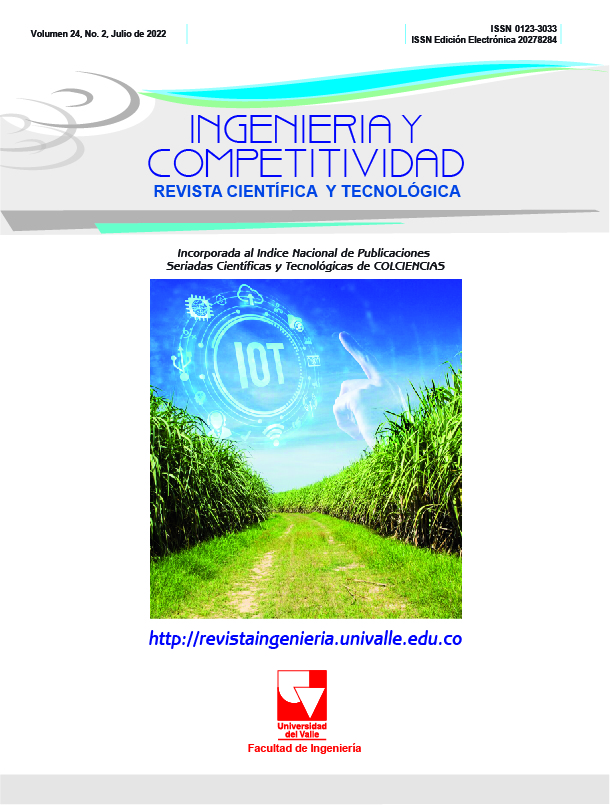Desarrollo de software para determinar constantes ópticas en películas delgadas semiconductoras no homogéneas
Contenido principal del artículo
En este trabajo se realizó el diseño y se desarrolló de una herramienta de software útil en el estudio de las propiedades ópticas de materiales semiconductores. Mediante este estudio es posible conocer si las películas delgadas semiconductoras no homogéneas sintetizadas son adecuadas para la fabricación de dispositivos semiconductores. Mediante el algoritmo desarrollado, basado en los métodos de Swanepoel, se logra estimar constantes ópticas de películas semiconductoras no homogéneas tales como: coeficiente de absorción (α), índice de refracción (n) y brecha de energía prohibida (Eg); además, se logra estimar la variación del espesor en ellas. Esta herramienta tiene como insumo la información en las curvas de transmitancia espectral resultantes de procedimientos experimentales. Se encontró que la herramienta propuesta ofrece un alto grado de confiabilidad y que, por tanto, se puede usar para estudiar las propiedades de películas delgadas semiconductoras que se utilicen en la fabricación de dispositivos semiconductores en diversas aplicaciones, entre ellas las energías limpias y renovables como son las celdas solares.
- Software
- Materiales semiconductores
- Película delgada
- Constantes ópticas
(1) REN21. 2021. Renewables 2021 Global Status Report (Paris: REN21 Secretariat). [Internet]. gsr 2021 full report en; [citado 12 octubre 2021]. Disponible en: https://www.ren21.net/reports/globalstatus-report/
(2) Poelman D, Philippe F. Methods for the determination of the optical constants of thin films from single transmission measurements: a critical review. J Phys D Appl Phys. 2003; 36(15): 1850-57. DOI: 10.1088/0022-3727/36/15/316
(3) Swanepoel R. Determination of the thickness and optical constants of amorphous silicon. J Phys E. 1983; 16(12): 1214-22. DOI: 10.1088/0022- 3735/16/12/023
(4) Swanepoel R. Determination of surface roughness and optical constants of inhomogeneous amorphous silicon films. J Phys E. 1984; 17(10): 896-903. DOI: 10.1088/0022-3735/17/10/023
(5) Vargas-Perea H, Rocha-González R, Botero-Londoño M, Sepúlveda-Sepúlveda A, Calderón-Triana C. Herramienta de software para determinar constantes ópticas en celdas solares tipo película delgada. Dyna (Medellín). 2018; 85(206): 321-28. DOI: 10.15446/dyna.v85n206.70003
(6) GANJOO, A y GOLOVCHAK, R. Computer program PARAV for calculating optical constants of thin films and bulk materials: Case study of amorphous semiconductors. En: Journal of Optoelectronics and Advanced Materials. Junio, 2008, vol. 10, Nro. 6. p. 1328-1332.
(7) CARICATO, A. P; FAZZI, A y LEGGIERI, G. A computer program for determination of thin films thickness and optical constants. En: Applied Surface Science. Julio, 2005, vol. 248, Nro. 1-4. p. 440-445.
(8) Moreno-Montoya L, Arango P. Caracterización estructural y morfológica de películas de ZnO crecidas sobre sustratos de vidrio. Dyna (Medellín). 2007; 74(151): 37- 45.
(9) Vallejo Lozada W. Desarrollo de materiales fotovoltaicos usados como ventana óptica en celdas solares [tesis doctoral en Internet]. Bogotá D C: Universidad Nacional de Colombia; 2011 [citada 12 mar 2021]. 75 p. Disponible en: https://repositorio.unal.edu.co/handle/unal/7 728
(10) Yu PY, Cardona M, Fundamentals of Semiconductors: Physics and Materials Properties [Internet]. 4 a ed. New York: Springer; 2010 [citado 16 mar 2021]. 775 p. Disponible en: http://dx.doi.org/10.1007/978-3-642-00710- 1
(11) Caricato AP, Fazzi A, Leggieri G. A computer program for determination of thin films thickness and optical constants. Appl Surf Sci. 2005; 248(1-4): 440-45. DOI: 10.1016/j.apsusc.2005.03.069
(12) National Renewable Energy Laboratory (NREL) [Internet]. Golden (Colorado): NREL; c2018. efficiency chart; [citado 18 mar 2021]. Disponible en: https://www.nrel.gov/pv/assets/images/effic iency-chart.png
(13) Aly S, Ahmed-Akl A. Influence of film thickness on optical absorption and energy gap of thermally evaporated CdS0.1Se0.9 thin films. Chalcogenide Lett. 2015; 12(10): 489- 96.
Descargas

Esta obra está bajo una licencia internacional Creative Commons Atribución-NoComercial-CompartirIgual 4.0.
Los autores que publican en esta revista están de acuerdo con los siguientes términos:
Los autores ceden los derechos patrimoniales a la revista y a la Universidad del Valle sobre los manuscritos aceptados, pero podrán hacer los reusos que consideren pertinentes por motivos profesionales, educativos, académicos o científicos, de acuerdo con los términos de la licencia que otorga la revista a todos sus artículos.
Los artículos serán publicados bajo la licencia Creative Commons 4.0 BY-NC-SA (de atribución, no comercial, sin obras derivadas).


 https://orcid.org/0000-0003-1706-3182
https://orcid.org/0000-0003-1706-3182  https://orcid.org/0000-0001-9123-2269
https://orcid.org/0000-0001-9123-2269 https://orcid.org/0000-0002-3370-0156
https://orcid.org/0000-0002-3370-0156 https://orcid.org/0000-0002-3149-2939
https://orcid.org/0000-0002-3149-2939 https://orcid.org/0000-0002-9643-5193
https://orcid.org/0000-0002-9643-5193


